Let’s start with the money shot….
Now that’s, in my opinion, a mouthwatering bowl of pasta. The pasta, Strozzapreti, the sauce, an Italian sausage ragú. I’m not going to get into all the legends behind the “invention” of strozzapreti, a traditional hand-rolled pasta from central Italy. The name translates as “priest stranglers” and I leave you to look up the stories. And, not to be confused with strangolopreti, with the same translation, but from the area around Naples, and referring to a particular type of spinach gnocchi. This is the first of three pastas that are part of a new class we’re offering, a sort of advanced pasta class (maybe I should make a series) of “thick hand-rolled pastas”. The other two, in upcoming posts, are umbricelli and pici. Maybe more….
First off, the dough. If you go way back, the tradition was probably just all flour and water, and there are still some who swear by that. I’m going to present these the way I learned to make them. I use half fine semolina flour and half bread or pasta flour (something with a bit more gluten), a small amount of salt, and warm water. Make the dough, let it sit, covered, for about half an hour, then roll it out (I use the hand-crank machine rather than a rolling pin, I don’t need to get that traditional). Then it’s basically cut into what look like short pappardelle – about 10cm or 4″ long, and 2cm or ¾” wide. They’re also slightly thicker than you’d roll out something like spaghetti or linguine or fettucine by one notch on the roller machine, but again, about the same as you’d roll out for pappardelle or lasagna noodles.
Now, if you go to something like YouTube, you’ll find dozens of videos showing you how to hand-roll strozzapreti, but, at least for the way I was taught, these are sort of shortcuts, because you end up with a simple coil or spiral by rolling each of those between your hands. The real, classic shape of a strozzapreti should have a sort of “s-curve” to it if you look at it in cross-section, and then be twisted afterwards. So the way I learned them, you make this little accordion, or s, pleat, leaving it somewhat loose…
…you can see the s-curve from the end (at least if you click on the photo to blow it up to full size). Once you’ve made that pleat, you simple twist the ends in opposite directions somewhere between one and one and a half twists, depending on how long they are. Again, you don’t want to twist them too tight, or they kind of mush together and you end up with a thick, dense noodle that doesn’t cook through well, and doesn’t have those cool grooves for grabbing the sauce.
It’s tedious work, but they’re worth it! Obviously, get a pot of salted water boiling and ready. These can go right into the pot as soon as you’re done twisting.
Back during those 30 minutes while the pasta is resting, before you roll it out, is a great time to get your sauce going. Finely chopped onion, leek, garlic, and a seeded chili get lightly browned in a little olive oil, then I add the meat of a couple of Italian sausages (or you can make your own sausage meat – whatever you prefer – these are half ground pork, half ground beef, with a fair amount of fennel seed in them). Once the sausage is browned, I add some finely chopped tomato (I throw a few plum tomatoes in the food processor and pulse them down). Then I turn the heat down and let the sauce simmer away until it gets a sort of ketchup-like consistency. Add a ladle or two of the pasta cooking water (while the pasta is in it, you want that starchiness) just before draining the pasta, enough to loosen it up into a slightly thin tomato sauce. Toss in a handful of chopped basil and parsley. Season to taste with salt and plenty of black pepper.
Drain the pasta, toss it with the sauce, it’ll absorb that extra liquid almost immediately and the sauce will thicken up and cling to the strozzapreti, getting into all those grooves. Then a good drizzle of a decent, spicy olive oil, toss it all together, and serve it up with a little grated Romano cheese. Let’s repeat the money shot!
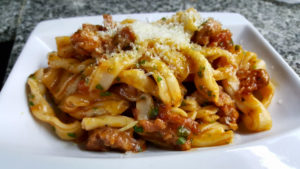
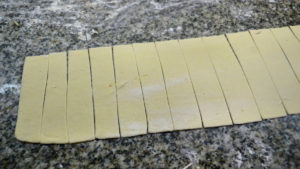
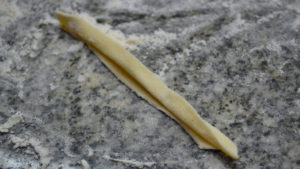
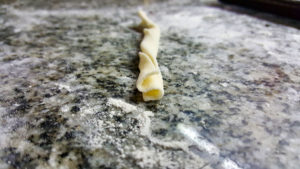
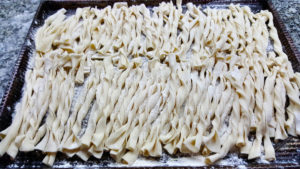
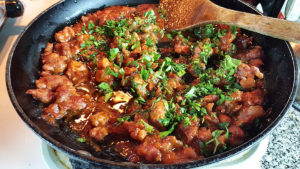
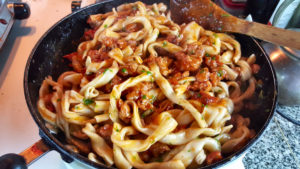
[…] with Chicken & Leek Cream – Handmade strozzapreti; sauce of leeks, garlic, pepperoncino (dried Italian chilies), cream, chicken stock, goat’s […]
[…] as you can, it just makes it somewhat easier for the next steps. This is a little thicker than the strozzapreti, from the last post in this series, and because of the way it’s shaped, it doesn’t work […]
[…] Strozzapreti with Aspargus and Goat’s Milk Feta – homemade strozzapreti with a saute of asparagus, shallots, lemon zest, green onion, peanuts, and feta cheese, in homemade […]
[…] & Feta Cheese Strozzapreti – hand-rolled strozzapreti; puré of sun-dried tomatoes, cashews, guajillo chilies underneath; saute of roasted asparagus and […]
[…] with Radish and Pistachio Pesto – handrolled semolina strozzapreti; pesto of radish and spinach leaves, toasted pistachios, garlic, sheep’s milk cheese, serrano […]
[…] of my personal favorites, hand-rolled strozzapreti with a parsley tinged dough that’s half semolina, half all-purpose flour, and no egg. I poach […]